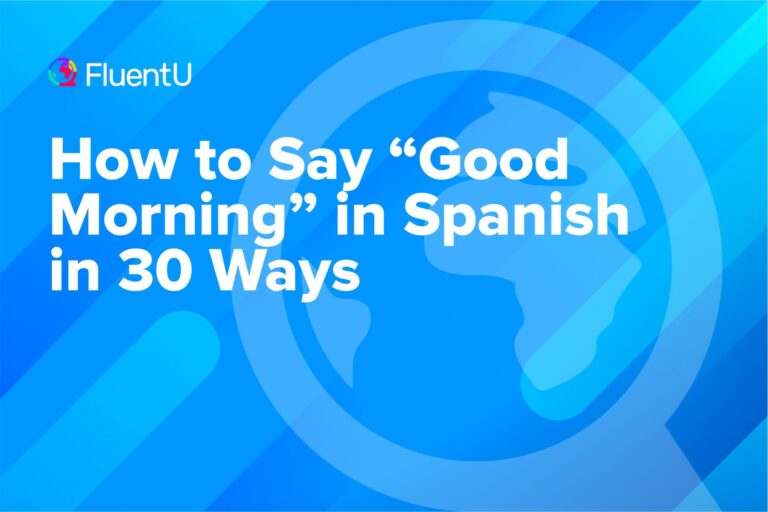Adjective Placement in Spanish

There’s no question that the sky is blue, no matter what language you’re speaking.
But is it a “blue sky” or a “sky blue?”
In English, adjectives come before nouns. In Spanish, they come after.
This post will teach you everything you need about Spanish adjective placement so you can construct grammatically correct, native-sounding sentences.
Download: This blog post is available as a convenient and portable PDF that you can take anywhere. Click here to get a copy. (Download)
The Formula for Spanish Adjective Placement in Sentences
The formula for using adjectives in a sentence is very simple in Spanish:
Noun + Adjective
In other words, you need to place the adjective after the noun it modifies.
I know it’s weird for English speakers, but once you practice a little, you’ll pick up the rule in no time.
Instead of a “blue car,” you’ll have a “car blue.” It’s almost poetic, isn’t it?
Here are some examples of Spanish sentences with adjectives:
Al cachorrito marrón le gusta a comer salchichas picantes. (The brown puppy likes to eat spicy sausages.)
Mi computadora portable está vieja. (My portable computer is old.)
Me gustan gorras escocesas con purpurina plateada. (I like plaid hats with silver glitter.)
Exceptions to the Spanish Adjective Placement Formula
Did you think that there wouldn’t be any exceptions to this rule?
That would be the case in a perfect world, but no language is perfect.
In some cases, adjectives go before the modified nouns (like in English). Here are the scenarios where you put the adjective first:
Proper nouns
Proper nouns are the specific names of nouns (people, places and things), like Miguel Cervantes, Salvador Dalí and Jorge Gutierrez.
El creativo Jorge Gutierrez se especializa en películas animadas. (The creative Jorge Gutierrez specializes in animated movies.)
Nouns or relations that we only have one of
You can’t have more than one state bird, president, nose, heart, etc.
El árido y frío Plutón ya no es una planeta. (The barren and cold Pluto is not a planet anymore.)
Inherent qualities of nouns or adjectives that always associate with a noun
For example, snow is always white, water is always wet and the sky is always blue.
La brillante estrella es conocida como Sirius o “la estrella del perro.” (The bright star is called Sirius or “the dog star.”)
Adjectives referring to a specific noun
Or in other words, when you know the specific noun the adjective is referencing.
El travieso perro del cuento se comió la tarea importante. (The naughty dog from the story ate the important homework.)
Adjectives Which Change Their Meaning Based on Placement
Sometimes, an adjective can mean more than one thing, depending on if it comes before or after its noun. Here are ten examples of this with some of the most common Spanish adjectives:
1. Grande
Before the noun: “great” or “important”
Example: Él es un gran amigo. (He is a great friend.)
After the noun: “big” or “large”
Example: La casa es grande. (The house is big.)
2. Nuevo
Before the noun: “brand new”
Example: Tengo un nuevo coche. (I have a brand new car.)
After the noun: “new to me” or “recently acquired”
Example: He comprado un coche nuevo. (I have bought a new car.)
3. Viejo
Before the noun: “former” or “previous”
Example: Mi viejo jefe era muy exigente. (My former boss was very demanding.)
After the noun: “old” or “aged”
Example: Mi abuela tiene un gato viejo. (My grandmother has an old cat.)
4. Pobre
Before the noun: “unfortunate” or “pitiful”
Example: El pobre hombre no tiene trabajo. (The poor man has no job.)
After the noun: “poor” or “having little money”
Example: La familia vive en una casa muy pobre. (The family lives in a very poor house.)
5. Mismo
Before the noun: “exact” or “identical”
Example: Necesito el mismo vestido que llevé ayer. (I need the same dress I wore yesterday.)
After the noun: “himself” or “herself”
Example: Ella lo hizo ella misma. (She did it herself.)
6. Bueno
Before the noun: “kind” or “generous”
Example: Él es un buen hombre. (He is a kind man.)
After the noun: “good” or “competent”
Example: Es un doctor muy bueno. (He is a very good doctor.)
7. Malo
Before the noun: “evil” or “wicked”
Example: Es un malo hombre. (He’s an evil man.)
After the noun: “poor quality” or “not good”
Example: Tengo un ojo malo. (I have a bad eye.)
8. Propio
Before the noun: “own”
Example: Tengo mi propio coche. (I have my own car.)
After the noun: “appropriate” or “fitting”
Example: Es el lugar propio para celebrar una boda. (It’s the appropriate place to celebrate a wedding.)
9. Único
Before the noun: “only” or “sole”
Example: Este es el único libro que tengo. (This is the only book I have.)
After the noun: “unique” or “one of a kind”
Example: Compró la pintura única. (He bought the unique painting.)
10. Primero
Before the noun: “first”
Example: Él es el primer hombre en llegar. (He’s the first man to arrive.)
After the noun: “main” or “primary”
Example: La razón primera es el dinero. (The primary reason is money.)
Possessives
Spanish possessives depict ownership, like “mine” and “yours,” and act as adjectives because they describe ownership of items.
Su pelo es muy bonito. (Her hair is very pretty.)
Demonstratives
Spanish demonstratives are words like “this,” that” and “those.” They come before a noun when used as an adjective but replace the noun when used as a pronoun.
Esta casa es muy cara. (This house is very expensive.)
Determiners
Determiners are small words that come before nouns and determine their meaning, the two most common types being definite articles (el, la, los, las) and indefinite articles (un, una, unos, unas).
Me gusta las manzanas verdes. (I like the green apples.)
Quiere un vaso de agua. (He wants a cup of water.)
Numbers
Numbers describe the quantity of nouns in Spanish.
Mi hermana tiene cuatro mascotas. (My sister has four pets.)
Keep in mind: when speaking Spanish, you always have to keep in mind gender and plurality, which can be a real issue for English natives.
The best way to become fluent in this Spanish skill is to practice, read, listen and write often.
Thanks to technology, you can easily immerse yourself in Spanish with language programs like FluentU, which offers thousands of Spanish videos paired with learning tools.
FluentU takes authentic videos—like music videos, movie trailers, news and inspiring talks—and turns them into personalized language learning lessons.
You can try FluentU for free for 2 weeks. Check out the website or download the iOS app or Android app.
P.S. If you decide to sign up now, you can take advantage of our current sale!

You can also select and adjective and see where it appears in a large library of authentic videos, or perhaps we should say una gran biblioteca de videos auténticos.
With a little daily practice, Spanish adjective placement can become just as easy as it is in English!
Download: This blog post is available as a convenient and portable PDF that you can take anywhere. Click here to get a copy. (Download)
And One More Thing…
If you've made it this far that means you probably enjoy learning Spanish with engaging material and will then love FluentU.
Other sites use scripted content. FluentU uses a natural approach that helps you ease into the Spanish language and culture over time. You’ll learn Spanish as it’s actually spoken by real people.
FluentU has a wide variety of videos, as you can see here:

FluentU brings native videos within reach with interactive transcripts. You can tap on any word to look it up instantly. Every definition has examples that have been written to help you understand how the word is used. If you see an interesting word you don’t know, you can add it to a vocab list.

Review a complete interactive transcript under the Dialogue tab, and find words and phrases listed under Vocab.

Learn all the vocabulary in any video with FluentU’s robust learning engine. Swipe left or right to see more examples of the word you’re on.

The best part is that FluentU keeps track of the vocabulary that you’re learning, and gives you extra practice with difficult words. It'll even remind you when it’s time to review what you’ve learned. Every learner has a truly personalized experience, even if they’re learning with the same video.
Start using the FluentU website on your computer or tablet or, better yet, download the FluentU app from the iTunes or Google Play store. Click here to take advantage of our current sale! (Expires at the end of this month.)







